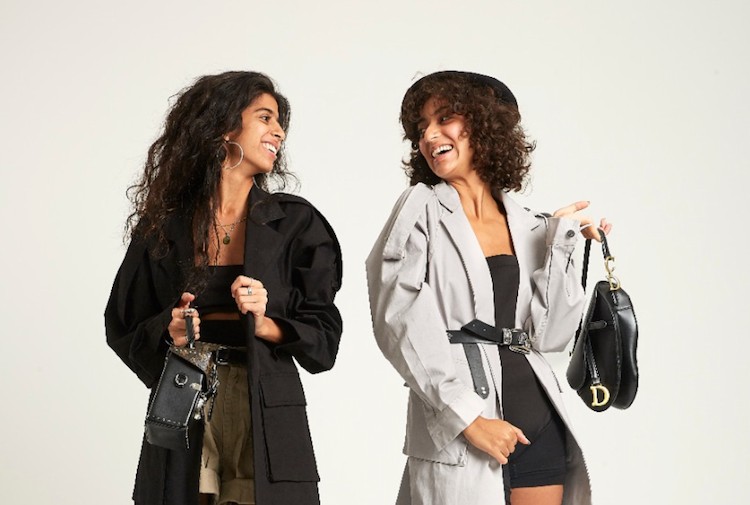Fashion E-commerce Trends - Navigating Challenges, Embracing Opportunities, And Innovations
Discover the latest fashion e-commerce trends, challenges, and innovations. From online shopping surges to virtual try-on tech and sustainable fashion, this article offers insights to navigate the evolving landscape and stay ahead of the curve.
Author:James PierceReviewer:Elisa MuellerFeb 21, 20242K Shares87.9K Views

Fashion e-commerce has emerged as a dynamic and rapidly evolving sector, reshaping the way consumers shop for clothing, accessories, and beauty products. With the advent of digital technologies, changing consumer behaviors, and shifting market dynamics, online fashion retail has experienced unprecedented growth and innovation in recent years. From the convenience of mobile shopping to the immersive experience of virtual try-on, Fashion E-commerce Trendsare revolutionizing the way people engage with fashion, offering unprecedented access, choice, and convenience.
In this article, we'll delve into the latest trends shaping the world of fashion e-commerce, exploring the impact of COVID-19, the rise of sustainable fashion, the influence of social commerce.
Shift Towards Online Shopping
The shift towards online shopping in the fashion industry has been nothing short of transformative, catalyzed by various factors including advancements in technology, changes in consumer behavior, and the impact of global events such as the COVID-19 pandemic.
In recent years, there has been a noticeable surge in online shopping for fashion items, driven largely by the convenience and accessibility offered by e-commerce platforms. Consumers can now browse through a vast array of clothing, accessories, and beauty products from the comfort of their homes, eliminating the need for physical store visits and tedious in-person shopping experiences.
However, the COVID-19 pandemic acted as a catalyst, accelerating the adoption of online shopping in the fashion industry. With lockdowns and social distancing measures in place, consumers turned to online retailers as their primary source for fashion purchases, leading to a significant increase in e-commerce sales.The closure of brick-and-mortar stores forced fashion brands to prioritize their online presence, invest in digital marketing strategies, and enhance their e-commerce platforms to meet the growing demand from online shoppers.
Mobile Shopping And Apps
The rise of mobile shopping and the widespread use of mobile apps have revolutionized the way consumers engage with fashion e-commerce. With smartphones becoming an indispensable part of daily life, more and more consumers are turning to their mobile devices to browse, shop, and interact with their favorite fashion brands. Mobile commerce, or m-commerce, has witnessed significant growth in recent years, driven by the increasing prevalence of smartphones and the convenience they offer.
Today, consumers can access a wide range of fashion products with just a few taps on their mobile screens, making it easier than ever to shop on the go or from the comfort of their homes. Fashion brands have responded to this trend by investing in mobile-friendly websites and developing dedicated mobile apps to enhance the shopping experience for mobile users.
Personalized Shopping Experiences
Personalized shopping experiences have become increasingly important in the world of fashion e-commerce, as consumers seek tailored recommendations and customized interactions that cater to their individual preferences and tastes. Advancements in technology, particularly in artificial intelligence (AI) and machine learning, have enabled fashion brands to analyze vast amounts of data, including browsing history, purchase behavior, and demographic information, to create personalized shopping experiences for their customers.
One of the key elements of personalized shopping experiences is AI-powered product recommendations. By leveraging algorithms that analyze a customer's past purchases, likes, and dislikes, fashion retailers can suggest relevant products that align with their unique style and preferences. This not only enhances the shopping experience for the customer but also increases the likelihood of conversion and repeat purchases.
Virtual Try-On And Augmented Reality
Virtual try-on and augmented reality (AR) technologies have emerged as innovative solutions to enhance the online shopping experience in the fashion industry. These technologies allow consumers to virtually try on clothing, accessories, and beauty products before making a purchase, bridging the gap between the digital and physical shopping experience. Virtual try-on experiences enable shoppers to visualize how a garment will look and fit on their body, helping them make more informed purchasing decisions and reducing the need for returns.
By simply uploading a photo or using their device's camera, consumers can see themselves wearing different outfits in real-time, exploring various styles, colors, and sizes from the comfort of their own homes. Augmented reality takes virtual try-on experiences to the next level by overlaying digital elements onto the physical world. AR technology allows consumers to see how a product will look in their own environment, whether it's trying on sunglasses or placing furniture in their living room.
This immersive experience not only enhances the shopping experience but also increases engagement and satisfaction.
Sustainable Fashion And Ethical Shopping
Sustainable fashion and ethical shopping have become increasingly important considerations for consumers and fashion brands alike, as awareness grows about the environmental and social impact of the fashion industry. Sustainable fashion refers to clothing and accessories that are produced in a way that minimizes harm to the environment and promotes social responsibility throughout the supply chain. This includes using eco-friendly materials, reducing waste and carbon emissions, and supporting fair labor practices.
Ethical shopping goes hand in hand with sustainable fashion, focusing on the social and ethical aspects of production, such as ensuring safe working conditions, fair wages, and humane treatment of workers. Ethical shoppers prioritize transparency and accountability, seeking out brands that uphold high ethical standards and prioritize the well-being of workers.
There is a growing awareness among consumers about the environmental and social impact of the fashion industry, driving increased demand for sustainable and ethically produced fashion products.
Social Commerce And Influencer Marketing
Social commerce and influencer marketing have emerged as powerful strategies for fashion brands to engage with consumers and drive sales in the digital age. Social commerce refers to the integration of e-commerce capabilities into social media platforms, allowing users to discover, browse, and purchase products directly within their social media feeds.
Platforms like Instagram, Facebook, and Pinterest have introduced features such as shoppable posts, tags, and stickers, enabling brands to turn their social media presence into a sales channel.
Influencer marketing, on the other hand, involves collaborating with individuals who have a significant following and influence on social media to promote products and brands. Influencers, ranging from celebrities to micro-influencers, have the ability to reach a wide audience and sway purchasing decisions through their authentic and relatable content.
Fashion brands are leveraging social commerce and influencer marketing to reach new audiences, drive traffic to their e-commerce websites, and increase sales. By partnering with influencers, brands can tap into their followers' trust and credibility, gaining access to a highly engaged and receptive audience.
Influencers often create content featuring products or outfits from fashion brands, showcasing them in a relatable and aspirational way. This content can take various forms, including sponsored posts, product reviews, unboxing videos, and styling tips, providing valuable exposure and endorsement for the brand.
Omnichannel Retailing
Omnichannel retailing is a holistic approach to retail that integrates various channels, including physical stores, websites, mobile apps, and social media platforms, to provide customers with a seamless and cohesive shopping experience.
In an omnichannel retail environment, the boundaries between online and offline channels are blurred, allowing customers to interact with the brand across multiple touchpoints and channels. For example, a customer might browse products on a brand's website, visit a physical store to try them on, and then make the final purchase through the brand's mobile app.
The key characteristic of omnichannel retailing is consistency. Regardless of the channel or touchpoint, customers should receive the same level of service, access to product information, and brand experience. This consistency creates a cohesive and integrated shopping journey, enhancing customer satisfaction and loyalty.
Subscription Services And Rental Models
Subscription services and rental models have emerged as popular alternatives to traditional retail, offering consumers new ways to access and experience fashion while promoting sustainability and affordability. Subscription services allow customers to pay a recurring fee in exchange for access to a curated selection of clothing, accessories, or beauty products on a regular basis.
Subscribers typically receive a box of items tailored to their preferences and style preferences, which they can keep for a set period before returning or exchanging for new items.
Rental models, on the other hand, allow customers to borrow clothing, accessories, or other fashion items for a temporary period, typically for a fraction of the cost of purchasing them outright. Customers can wear the items for a special occasion or as part of their everyday wardrobe, returning them when they are finished or ready for something new.
Both subscription services and rental models offer several benefits for consumers. Firstly, they provide access to a wide range of designer and luxury items that may be otherwise unaffordable or inaccessible to the average consumer.
Secondly, they promote sustainability by reducing the need for consumers to purchase new items and encouraging the reuse and sharing of clothing and accessories. Finally, they offer flexibility and convenience, allowing consumers to try out new styles and trends without committing to a long-term purchase.
Data Analytics And Customer Insights
Data analytics and customer insights play a crucial role in shaping the success of fashion e-commerce businesses by providing valuable information about consumer behavior, preferences, and trends.
Data analytics involves the collection, analysis, and interpretation of data to uncover patterns, trends, and insights that can be used to inform business decisions. In the context of fashion e-commerce, data analytics allows brands to track key metrics such as website traffic, conversion rates, and sales performance, providing valuable insights into the effectiveness of marketing campaigns, product offerings, and customer engagement strategies.
Customer insights, on the other hand, involve a deeper understanding of consumer behavior, preferences, and needs. By analyzing data from various sources such as website interactions, social media engagement, and purchase history, fashion brands can gain insights into who their customers are, what they like, and how they prefer to shop.
Challenges And Opportunities
Challenges and opportunities are inherent aspects of the fashion e-commerce landscape, presenting both hurdles to overcome and avenues for growth and innovation. One of the primary challenges facing fashion e-commerce brands is competition and market saturation.
With the proliferation of online retailers and the ease of entry into the market, brands must contend with a crowded marketplace and intense competition for consumer attention and dollars. This saturation can make it difficult for brands to stand out and differentiate themselves from competitors, leading to pricing pressure and margin erosion.
Furthermore, fashion e-commerce brands face challenges related to customer acquisition and retention. With an abundance of choices available to consumers, brands must invest in marketing strategies to attract and retain customers, driving up customer acquisition costs and putting pressure on profit margins.
Additionally, retaining customers in the long term requires brands to deliver exceptional customer experiences, personalized service, and value-added benefits that keep customers coming back for more.
FAQs abou Fashion E-commerce Trends
How Has The COVID-19 Pandemic Impacted Fashion E-commerce?
The pandemic has accelerated the shift towards online shopping, with more consumers turning to e-commerce platforms for their fashion needs due to lockdowns and social distancing measures.
What Role Do Virtual Try-on Experiences Play In The Online Fashion Shopping Experience?
Virtual try-on experiences allow consumers to visualize how clothing and accessories will look and fit before making a purchase, reducing the likelihood of returns and enhancing the overall shopping experience.
Why Is Sustainability Becoming Increasingly Important In The Fashion Industry?
There is growing awareness among consumers about the environmental and social impact of the fashion industry, leading to increased demand for sustainable and ethically produced fashion products.
How Are Fashion Brands Leveraging Data Analytics To Drive Business Growth?
Fashion brands are utilizing data analytics to gain insights into consumer preferences, trends, and market dynamics, enabling them to make informed decisions about product development, marketing strategies, and inventory management.
What Are Some Key Trends Shaping The Future Of Fashion E-commerce?
Anticipated trends include continued growth in mobile shopping, virtual try-on experiences, sustainable fashion, and social commerce, with brands prioritizing innovation, sustainability, and customer-centricity to stay competitive in the evolving market.
Conclusion
Fashion e-commerce trends is undergoing a period of rapid transformation, driven by technological innovation, shifting consumer preferences, and market dynamics. From the rise of mobile shopping to the adoption of virtual try-on experiences and the growing demand for sustainable fashion, the industry is experiencing unprecedented change and evolution.
By staying attuned to emerging trends, leveraging technology, and prioritizing customer-centricity, fashion brands can navigate the challenges and seize the opportunities presented by the evolving landscape of online retail.
Jump to
Shift Towards Online Shopping
Mobile Shopping And Apps
Personalized Shopping Experiences
Virtual Try-On And Augmented Reality
Sustainable Fashion And Ethical Shopping
Social Commerce And Influencer Marketing
Omnichannel Retailing
Subscription Services And Rental Models
Data Analytics And Customer Insights
Challenges And Opportunities
FAQs abou Fashion E-commerce Trends
Conclusion

James Pierce
Author

Elisa Mueller
Reviewer
Latest Articles
Popular Articles


